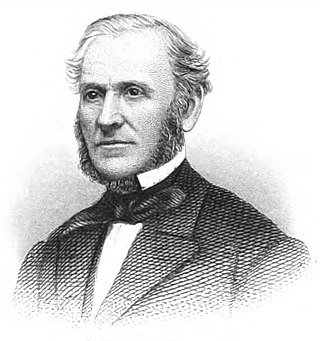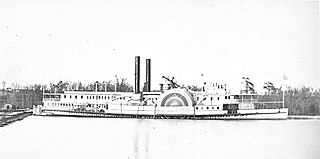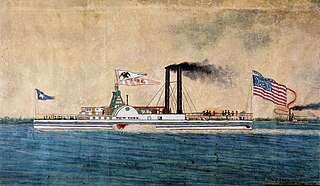
A steamship, often referred to as a steamer, is a type of steam-powered vessel, typically ocean-faring and seaworthy, that is propelled by one or more steam engines that typically move (turn) propellers or paddlewheels. The first steamships came into practical usage during the early 1800s; however, there were exceptions that came before. Steamships usually use the prefix designations of "PS" for paddle steamer or "SS" for screw steamer. As paddle steamers became less common, "SS" is assumed by many to stand for "steamship". Ships powered by internal combustion engines use a prefix such as "MV" for motor vessel, so it is not correct to use "SS" for most modern vessels.

A steamboat is a boat that is propelled primarily by steam power, typically driving propellers or paddlewheels. Steamboats sometimes use the prefix designation SS, S.S. or S/S or PS ; however, these designations are most often used for steamships.

SS Savannah was an American hybrid sailing ship/sidewheel steamer built in 1818. She was the first steamship to cross the Atlantic Ocean, transiting mainly under sail power from May to June 1819. In spite of this historic voyage, the great space taken up by her large engine and its fuel at the expense of cargo, and the public's anxiety over embracing her revolutionary steam power, kept Savannah from being a commercial success as a steamship. Originally laid down as a sailing packet, she was, following a severe and unrelated reversal of the financial fortunes of her owners, converted back into a sailing ship shortly after returning from Europe.

Charles Morgan was an American railroad and shipping magnate. He played a leading role in the development of transportation and commerce in the Southern United States through the mid- to late-19th century.

The Morgan Iron Works was a 19th-century manufacturing plant for marine steam engines located in New York City, United States. Founded as T. F. Secor & Co. in 1838, the plant was later taken over and renamed by one of its original investors, Charles Morgan.

SS Pacific was a wooden-hulled, sidewheel steamer built in 1849 for transatlantic service with the American Collins Line. Designed to outclass their chief rivals from the British-owned Cunard Line, Pacific and her three sister ships were the largest, fastest and most well-appointed transatlantic steamers of their day.

Bristol was a large sidewheel steamboat launched in 1866 by William H. Webb of New York for the Merchants Steamship Company. One of Narragansett Bay's so-called "floating palaces", the luxuriously outfitted Bristol and her sister ship Providence, each of which could carry up to 1,200 passengers, were installed with the largest engines then built in the United States, and were considered to be amongst the finest American-built vessels of their era.

Providence was a large sidewheel steamer launched in 1866 by William H. Webb of New York for the Merchants Steamship Company. The first of Narragansett Bay's so-called "floating palaces", the luxuriously outfitted Providence and her sister ship Bristol, each of which could carry up to 1,200 passengers, were installed with the largest engines then built in the United States, and were considered to be amongst the finest American-built vessels of their era.

A marine steam engine is a steam engine that is used to power a ship or boat. This article deals mainly with marine steam engines of the reciprocating type, which were in use from the inception of the steamboat in the early 19th century to their last years of large-scale manufacture during World War II. Reciprocating steam engines were progressively replaced in marine applications during the 20th century by steam turbines and marine diesel engines.

The Etna Iron Works was a 19th-century ironworks and manufacturing plant for marine steam engines located in New York City. The Etna Works was a failing small business when purchased by ironmolder John Roach and three partners in 1852. Roach soon gained full ownership of the business and quickly transformed it into a successful general-purpose ironworks.
The Delaware River Iron Ship Building and Engine Works, was a major late-19th-century American shipyard located on the Delaware River in Chester, Pennsylvania. It was founded by the industrialist John Roach and is often referred to by its parent company name of John Roach & Sons, or just known as the Roach shipyard. For the first fifteen years of its existence, the shipyard was by far the largest and most productive in the United States, building more tonnage of ships than its next two major competitors combined, in addition to being the U.S. Navy's largest contractor. The yard specialized in the production of large passenger freighters, but built every kind of vessel from warships to cargo ships, oil tankers, ferries, barges, tugs and yachts.

Henry Eckford was a small passenger-cargo steamboat built in New York in 1824. She was the first steam vessel in the world to be installed with a compound engine, almost fifty years before the technology would become widely adopted for marine use.
Lawrence & Foulks was a 19th-century American shipbuilding company based in New York. Established in the early 1850s, the company built 144 vessels of all types over the course of some fifty years, but is best known for its production of high-speed wooden-hulled steamboats and steamships. Notable vessels built by the company include the record-breaking Hudson River steamboat Chauncey Vibbard, the luxury Long Island Sound steamer Commonwealth, and the fast oceangoing steamships—later U.S. Navy gunboats—Bienville and De Soto. In addition to the domestic market, the company also built ships for service as far afield as South America and China.

Commonwealth was a large sidewheel steamboat built in 1854–55 for passenger service on Long Island Sound. The most celebrated Sound steamer of her day, Commonwealth was especially noted for the elegance and comfort of her passenger accommodations, which included gas lighting, steam heating, and an "enchantingly beautiful" domed roof in her upper saloon. Her stability of motion led her captain to describe Commonwealth as the finest rough weather steamboat ever built in the United States.

Theodosius Fowler Secor was an American marine engineer. Secor co-founded T. F. Secor & Co. in New York in 1838, which was one of the leading American marine engineering facilities of its day. In 1850, he sold his stake in the company to his erstwhile partner, Charles Morgan, in order to go into partnership with Cornelius Vanderbilt in the purchase of another leading New York marine engineering facility, the Allaire Iron Works.

Thomas Powell was a fast and popular steamboat built in Manhattan, New York City in 1846 for service on the Hudson River. She ran between New York City and various Hudson River destinations during her career, including Newburgh, Piermont, Poughkeepsie, Rondout, Catskill, and finally as a nightboat to Troy. She also ran on the Delaware River for some years in the 1850s, and during the American Civil War served as a Union Army dispatch boat.
Orus was a wooden side-wheel steamship built in 1842. After a short commercial career connecting ports in New Jersey to lower Manhattan, she was employed in some of the earliest attempts to develop transcontinental shipping routes across Panama and later, across Nicaragua. She was wrecked in 1850 attempting to ascend the San Juan River in Nicaragua.

New York was an American passenger-cargo sidewheel steamboat built in 1836 for service on Long Island Sound. When new, she was the largest steamboat yet to operate on the route between New York and New Haven, Connecticut, and was one of the largest Sound steamboats of her day.
Erik Heyl (1887–1973) was an American maritime historian and illustrator. He is best known as the author of Early American Steamers, a six-volume work that incorporates illustrations, technical details and service histories of almost 800 steamboats and steamships built mainly in the United States between 1807 and 1870.

The West Street Foundry was an American steam engineering works notable for producing marine steam engines in the mid-19th century. Based in Brooklyn, New York, the company built at least 27 marine engines between 1845 and 1855, including engines for some of the fastest and finest steamboats of the era. The company also built and repaired steam engines and boilers of all types, as well as doing other metalwork. The company failed and was liquidated in 1855.




















